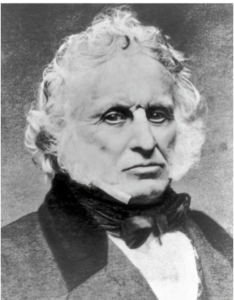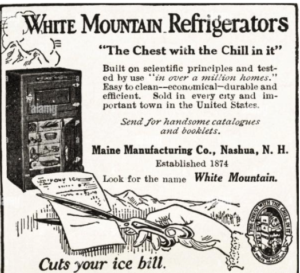Yankee Ingenuity at Its Best
an article by Robert Spellman
Imagine you are a Wakefield farmer. It’s February and it is 200 years ago. Your farm is dormant. You’ve tended to the animals, stored hay and firewood, repaired your tools and you are ready for spring. Now what? Your wife still has her daily chores – cooking, cleaning, mending, taking care of the kids, supervising you. But what are you going to do? There’s no electricity to power any of the boredom abating gadgets we have today. Over a glass of rum or whiskey (which sold for 25 cents a gallon), you and your friends repine over a crop that you could harvest in the depths of winter. But it was just the booze talking, because everyone knows that nothing grows this time of year.
“Ice does”, says Frederic Tudor. Fred is from a very rich Boston Brahmin family. Among other extravagances, they have an ice house. Fred has recently dropped out of Harvard and taken a trip to the Caribbean island of Martinique. He found that the variety of food they have is limited
because they can’t preserve food – no cool root cellars like we have. So, Fred thinks: We’ve got ice, that cools stuff. Ice is free, but it melts. To prevent that, I’ll pack it in sawdust. Sawdust is free too. I’ll hire farmers who haven’t got anything to do in winter. They’ll come cheap. I’ll sell
ice to people who have never seen it and don’t realize they want it. Chilled drinks and drinks with ice in the glass are so integral to our lives, that we don’t think of a time without ice, but this concept was revolutionary for most of the world.
“I know this”, said Fred, “A man who has drunk his drinks cold for one week can never be presented with them warm again.” So, with Fred’s extensive market research and detailed business plan – a free product and no demand, but the possibilities are endless. Fred opens the
Tudor Ice Company, the first ice production company in the world. The year is 1805 and Fred is 23.
As you can imagine, most people including his rich family thought Fred was nuts. But on February 10, 1806, Fred harvested ice from a pond in Lynn, MA, loaded it on to his own sailing ship the Favorite and embarked for Martinique. On that day a short blurb appeared in the Boston
Gazette. It read: “No joke. A vessel has cleared at the Custom House for Martinique with a cargo of ice. We hope this will not prove a slippery speculation.” (Shame on The Boston Gazette for this low humor. Let’s pray that there is no more of that.)
Well, there were fits and starts, but Fred Tudor, known as the “Ice King” persevered. This magnificently complex Yankee went from rags to riches a few times and spent time in debtors prison, yet created an entire industry. People could no longer live without easily preserved food
or ice cream and cold beer on a hot day. When he died at the age of 80 he was worth $11,000,000. Today, that’s $200 million.

Frederic Tudor, “The Ice King”.
The photographer said, “Hey, Mr. Tutor, how about smiling?” Mr. Tudor replied, “I am.”
I have to leave Fred now and get on with the story, but you can learn plenty about “The Ice King” online. The Harvard Business School even has his diary in their website archives. For the next hundred and twenty years, the ice harvesting business flourished. At first ice was used by businesses such as meat packers, dairies, restaurants, breweries and markets to preserve food. But soon consumers were able to buy “ice boxes” or “cold closets”– wooden cabinets lined with zinc or lead. In 1874 the Maine Manufacturing Company (Fairfield, ME, later Nashua, NH)
produced their “White Mountain” brand. A block of ice was placed in the top section of the cabinet and air circulated around the inside of the box. They called it a “refrigerator.” Although the word had been in existence since 1611, this was the first time a refrigerator was called a
refrigerator.

Fast forward to 1880 and that’s when we get involved. Charles McLean, Israel Horn, Francis Holmans and Jeremiah Flanders arrived in Wolfeboro Junction (Sanbornville) and purchased 1,000 feet of shoreline property along the western end of Lovell Lake for… (Guess how much it cost.) The location was critical as the Boston and Maine Railroad laid tracks along the edge of the lake so ice could be loaded easily onto railroad cars.

The property was split between two companies: The Independent Ice Company (Cambridge) and the Driver’s Union Ice Company (Wakefield). The companies constructed two giant buildings each one was 150 feet long and 32 feet wide. That’s a football field of ice storage. The two buildings consisted of 18 separate ice storage "houses" with a surprising capacity. Each of the houses could store 3,000 for a total of 54,000 tons. To help you visualize the weight and size, imagine a 1997 VW Beetle made out of ice. Now imagine 54,000 of them stored between The Cemetery and Witchtrot Road. Twenty years later the companies merged with the Boston Ice Company and four more buildings were built which added 64,000 tons of storage.

Photo of ice houses (1904). The horses have “groovers” attached for marking grids on the ice.
Oh, before I forget…the men paid $75 for the 1,000 feet of shoreline (or $2,300 in today’s dollars.) How much shoreline property would $2,300 buy you today?
Let’s take a break from the numbers for a minute and look at the effort it took to get the ice out of Lovell Lake. On average between 150 and 200 men worked on the harvest – no Gortex, no hand warmers and Leon Leonwood Bean wouldn’t make boots for forty years. Here are the steps:
1) First, they had to remove the snow from the top of the ice and move it off the lake.
2) Then, they measured uniform grids and cut grooves in the ice. Each block was cut 44 inches (height and width) and the depth (thickness of the ice) was usually 12-15 inches. They used horses to move the machines around. The animals were shod with crampon style horseshoes, but a lot of them slipped, fell into the water and made a mess. The blocks needed to be uniform so they could be loaded efficiently onto railroad cars and ships. Mr. Tudor found out the hard way that irregular chunks of ice placed in the hull of a ship move around during a storm and cause the vessel to list and sink.
3) Next, the workers sawed through the grooves to make blocks. The men used an ice gaff, an ice pick, tongs, “break-off bars” and saws for this purpose.

If the man on the right makes another cut, do you think he is going to fall in?
4) The cut blocks were then floated down the lake to the ice houses, then sent up a ramp and stored. Sawdust was used to between layers and on top to insulate the ice. This technique worked better than you think.
How well? The ice could be stored all winter and spring and sent to Boston throughout the year. Then, Lovell Lake (in a solid state) was loaded onto ships and sent around the world. Voyages to the Far East took four months and traversed 16,000 miles. And so it went for 50 years. Our ice, just like our LLA members, was famous for its quality. Even the famous Queen Victoria purchased New England ice. I am quite sure that the Queen’s ice came from in front of my house, but it’s tough to prove.

It took about an acre of our lake to produce 1,000 tons of ice. Get this, in 1919 the total weight of the ice taken out of Lovell Lake was 119,000 tons. In 1906 Boston and Maine Railroad built 1,000 ice cars that held between 15 and 33 tons each. On any given day throughout the year, 20-
30 railroad cars were loaded and sent to Boston.

Train loading in winter (1905). Note the train, the stack of ice, and mound of waste ice and snow on left.
By the early 1900’s, several other northern states were selling their frozen lakes. At its peak, the U.S. produced about 10 million tons of it and the industry employed 90,000. If my numbers are right, we produced about 1.2% of the total. Pretty good, I’d say.
Then came the meltdown (sorry). As this industry was started by a Yankee, it’s fitting that a Yankee should start its demise. In 1834, Jacob Perkins from Newburyport obtained a patent for a machine that made ice through a process of “evaporation” (I don’t know what that means
either.) Other inventors soon followed with their own processes. While these inventions portended the end, it was the introduction of electricity to the home that iced it (sorry). In 1913 Fred W. Wolf invented the domestic electric refrigerator and the ice harvesting industry began to
dissolve. The last Lovell Lake ice house was taken down in 1931 and that was that.
Epilogue
A couple of nearby lakes continue the tradition usually in the first couple of weeks in February: The Thompson Ice House Harvesting Museum in South Bristol, Maine hosts a volunteer ice harvest each winter. Kezar Lake in North Sutton (near Mt. Kearsarge) holds a Muster Field
Farms Ice Day Harvest.
My favorite is the story of Rockywold Deephaven Camp in Holderness, which has been in continuous operations since 1897. The camp supervisor, staff and volunteers harvest about 200 tons of ice from Squam Lake and truck it to their campground. The harvest was February 16-18. These photos show the process.





After the ice is harvested, the staff trucks it to the camp and stores it in ice houses until the ground thaws. Then the staff buries the ice in the ground and covers it with pine sawdust. Doing so keeps the ice frozen until summer. When needed, the staff digs up blocks of ice, loads them
on wheel barrows, rolls them to their guests’ cabins and places them in old fashioned ice boxes. Dave Lacasse, maintenance supervisor for the camp, reports that many of his summer guests arrive stressed and uptight, but the peacefulness and nostalgia associated with the old ice boxes helps their guests chill out. (Sorry)

